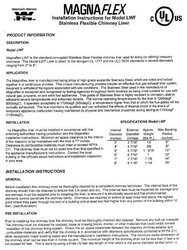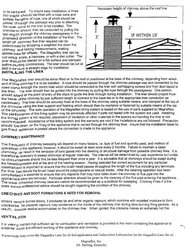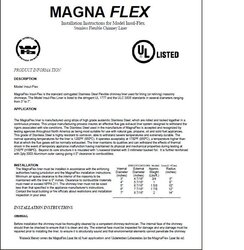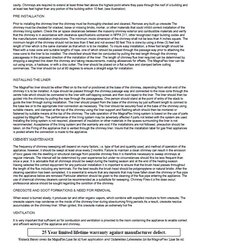Edited to add, that I provide this here as my review or impression of this product as it doesn't seem too many have used it yet.
We installed our stove today - won't get it running till maybe tomorrow.
We went with the Magnaflex Insulflex pre-insulated liner kit, which came from a contact here on hearth.com, The Heat Element. The kit included 20' of insulated liner, a collar for the bottom connection to the stove, and a top plate and rain cap. The price was very good and we didn't have to mess with the insulation blanket, adhesive, and mesh sleeve, it was all-in-one and ready for installation.
http://docs.google.com/fileview?id=...GItODViYy00YmJmLTk2ZGUtMWJiNzVjNGRkN2Uw&hl=en
Although the outer layer is advertised as "flexible aluminum," it's actually very strong, appearing nearly as strong as the inner liner (or at least, it is of the same construction method.) It is NOT aluminum foil or flimsy stuff on the outside by any means.
This was a 6" liner and the outer layer makes the whole thing about 7" around. It hooked up to a 6" collar at the bottom by stripping away the outer layer and insulation and sandwiching the actual stainless liner into the adapter. The cap that was included in this kit actually fits a 7" liner, so in this case the outer liner secures to the inside of the raised cap flue.
Turned out I really only needed a 15' kit (just ordered more to be sure) and I have a very large and fairly straight flue, so perhaps I am not the best example to prove flexibility, but it certainly didn't have much trouble with the short bend forward from my damper to the stove collar. I am not sure how bulky or difficult the "normal" insulated liners would be to install so I have no basis for comparison, however it does seem to me that if one needed an insulated liner in a flue that was smaller in diameter, but taller than mine, and with some bends, this stuff would probably do pretty well with a guide rope at the bottom and being fed in, as it is quite strong. You would, of course, need at the least 7" clearance all the way, for this 6" liner. Meaning it's not so flexible that it could "squeeze" as a whole to smaller in diameter or anything (like I suppose it might if it really WAS just foil type material on the exterior.)
As far as insulation capabilities I also don't know how it would compare to the blanket insulation kits, whether it is as thick etc. But it seems like it certainly ought to do the job. I was only doing insulated to be extra careful anyway as I've an interior chimney. The additional cost for insulated liner versus non-insulated did not seem like that much to me considering the positive things it can do (help the draft, maybe less sweeping or buildup, additional safety peace of mind). I also don't know what the cost for a regular liner with the blanket kit would cost, nor whether there would be any difference in the quality of the interior ss liner.)
The Heat Element was helpful with questions as well. It seems to me that a little more in the way of instructional paperwork might have helped if it were included in the kit so I wouldn't have had the questions at all, but then again perhaps this is just common sense but I am too much a newbie to know it! (I simply mean the part about stripping the outer layer for the bottom connection but not the top, etc.)
Anyway, I just wanted to post this review of my impressions so far of this new product. I think it is pretty neat and I am favorably impressed so far.
We installed our stove today - won't get it running till maybe tomorrow.
We went with the Magnaflex Insulflex pre-insulated liner kit, which came from a contact here on hearth.com, The Heat Element. The kit included 20' of insulated liner, a collar for the bottom connection to the stove, and a top plate and rain cap. The price was very good and we didn't have to mess with the insulation blanket, adhesive, and mesh sleeve, it was all-in-one and ready for installation.
http://docs.google.com/fileview?id=...GItODViYy00YmJmLTk2ZGUtMWJiNzVjNGRkN2Uw&hl=en
Although the outer layer is advertised as "flexible aluminum," it's actually very strong, appearing nearly as strong as the inner liner (or at least, it is of the same construction method.) It is NOT aluminum foil or flimsy stuff on the outside by any means.
This was a 6" liner and the outer layer makes the whole thing about 7" around. It hooked up to a 6" collar at the bottom by stripping away the outer layer and insulation and sandwiching the actual stainless liner into the adapter. The cap that was included in this kit actually fits a 7" liner, so in this case the outer liner secures to the inside of the raised cap flue.
Turned out I really only needed a 15' kit (just ordered more to be sure) and I have a very large and fairly straight flue, so perhaps I am not the best example to prove flexibility, but it certainly didn't have much trouble with the short bend forward from my damper to the stove collar. I am not sure how bulky or difficult the "normal" insulated liners would be to install so I have no basis for comparison, however it does seem to me that if one needed an insulated liner in a flue that was smaller in diameter, but taller than mine, and with some bends, this stuff would probably do pretty well with a guide rope at the bottom and being fed in, as it is quite strong. You would, of course, need at the least 7" clearance all the way, for this 6" liner. Meaning it's not so flexible that it could "squeeze" as a whole to smaller in diameter or anything (like I suppose it might if it really WAS just foil type material on the exterior.)
As far as insulation capabilities I also don't know how it would compare to the blanket insulation kits, whether it is as thick etc. But it seems like it certainly ought to do the job. I was only doing insulated to be extra careful anyway as I've an interior chimney. The additional cost for insulated liner versus non-insulated did not seem like that much to me considering the positive things it can do (help the draft, maybe less sweeping or buildup, additional safety peace of mind). I also don't know what the cost for a regular liner with the blanket kit would cost, nor whether there would be any difference in the quality of the interior ss liner.)
The Heat Element was helpful with questions as well. It seems to me that a little more in the way of instructional paperwork might have helped if it were included in the kit so I wouldn't have had the questions at all, but then again perhaps this is just common sense but I am too much a newbie to know it! (I simply mean the part about stripping the outer layer for the bottom connection but not the top, etc.)
Anyway, I just wanted to post this review of my impressions so far of this new product. I think it is pretty neat and I am favorably impressed so far.






